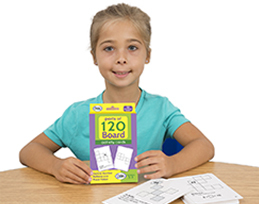Making Sense of Numbers on the 120 Board
- By Matt Christiansen
- Mar 21, 2019
When I first started visiting elementary school classrooms, I noticed that almost all of them had a hundreds chart somewhere in the room. It might have been a pocket chart, or maybe a poster on the wall, but it was always there as an instructional tool. Then, about ten years ago, the mathematics community agreed that rather than stopping at 100, this chart should go to 120. This change would address students’ struggles with “turning the century,” helping them recognize that the number after 100 is 101 and that counting continues from there.
The 120 chart has become standard in most classrooms now, and it still serves its purpose in helping students learn to count and find patterns in the numbers. Perhaps one of the most powerful uses of the 120 chart is in helping students recognize both the one more/one less relationships and the ten more/ten less relationships that are found throughout. Sometimes, however, these are not easy for students to see because they get lost in the overall magnitude of the chart.
Parts of the Puzzle
Didax Parts of 120 Board Activity Cards address this concern by focusing on only a small part of the chart. By “cutting out” a portion of the chart and looking at the patterns in that section, students gain experience with the place value relationships that help up make numbers. Removing all but one of the numbers in the cut out section gives students a starting point for using the patterns to complete the number puzzle.

In this section, students must use the one more/one less relationship and the ten more/ten less relationship to complete the chart section. There are many rich discussions that can come as students determine how to use these relationships to complete and check their responses. They should also be encouraged to discuss the changes in terms of place value – what is happening in the ones place and in the tens place as they apply the relationships.
Without a Clue
For an increased challenge, present students a section without a starting point or clue. These kinds of open sections allow students to explore relationships that they are comfortable with. They also open the door to interesting discussions if their pattern doesn’t stop at a 10 on the right side or end in a 1 on the left edge.v

Going Further
Ask students questions to extend their thinking about the numbers in the section of the chart they are working with. For example, you might ask them how many groups of 5 are in 35, or how many odd numbers there are in this part of the chart. You could also ask them to round to the nearest ten, or to find the missing addend in a problem. The possibilities are numerous and will help students think about numbers as part of a system with which we work every day. These Activity Cards include extension questions on every card to promote this critical thinking about number relationships.








 © 2025 Didax, Inc. All Rights Reserved.
© 2025 Didax, Inc. All Rights Reserved.